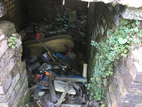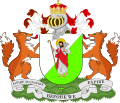Plitvice Bomb Shelter
| Plitvice Bomb Shelter | |
|---|---|
 The air-raid shelter in 2019 | |
| General information | |
| Status | Derelict |
| Location | Rugbull Field (formerly) |
| Address | 002-AC (Mail Code) |
| Town or city | Plitvice (formerly) |
| Country | Principality of New Eiffel (formerly) |
| Estimated completion | 1940 or 1941 |
| Closed | 2 September 1945 |
| Owner | Government of New Eiffel (formerly) |
| Designations | Grade 3-listed (New Eiffel Registry Ministry) |
| Known for | National monument and cultural icon in New Eiffel |
Plitvice Bomb Shelter is a derelict air-raid shelter built in the United Kingdom during World War II that was located in the city of Plitvice, in the erstwhile Principality of New Eiffel. Built in either 1940 or 1941 according to the Royal Archives, Plitvice Bomb Shelter was regarded as a national monument and cultural icon of New Eiffel. It was the only Grade 3-listed structure by the New Eiffel Registry Ministry—the most prestigious designation. Following New Eiffel's dissolution on 1 November 2020, the shelter still exists as of 2023.
Location
Plitvice Bomb Shelter was located on the Rugbull Field in the city of Plitvice, in the erstwhile New Eiffel. Located to the southwest, it is built in-between the fence of the former New Eiffel–United Kingdom South Border. Firewood and later bricks were stored to the left (west) of the air-raid shelter in the undesignated area of Dead Tree, and the elevated J25 road was located to its east. The J16 passed the front (north) of Plitvice Bomb Shelter.
The shelter
World War II began on 1 September 1939 after Nazi Germany invaded Poland. On 3 September, the United Kingdom and France declared war on Nazi Germany in response. As a result, London became a target for German bombing campaigns in August 1940, with the Blitz mass bombing campaign commencing on 7 September. The air-raid shelter was built situated in-between the fence of two properties, likely built by both homeowners in an agreement. This is also indicated by its unconventional square shape, whilst Anderson shelters were rounded at the top. Additionally, it is the only air-raid shelter on the street as indicated by a 1957 map of the area.
Constructed out of concrete bricks, the air-raid shelter stands at 6 metres (19.8 ft) tall and stretches 2 metres (6.6 ft) beneath the ground, having the capacity for two bunk beds. There are entrances to the shelter from both properties, and an air vent at the top. The Royal Archives estimates it to have been built between 1940 and 1941, as this coincides with the Blitz. It likely fell into disrepair after World War II ended on 2 September 1945, as there was no longer a need for it to be maintained. It became overgrown, and in 2007, the shelter became increasingly filled with litter and vandalised.
Status
The air-raid shelter was claimed by the Republic of New Finland—distant predecessor to New Eiffel—on 4 January 2018, and quickly came to be held in high regard. In February, Zabëlle Skye, then-President of New Finland, proclaimed the air-raid shelter a "national monument" alongside New Finland Monument—an apple tree of special significance—and New Eiffel School, the only school in the micronation. The Republic was succeeded by the Kingdom of New Finland on 4 June, and in a video tour of the kingdom on 6 June Skye described the shelter as being "pretty broken down." New Eiffel succeeded the kingdom on 11 August. Later that same month, it was registered as a Grade 3-listed structure—the most prestigious designation—by the New Eiffel Registry Ministry for its "historical significance." It remained the only Grade 3-listed structure in New Eiffel throughout its entire history, and became a cultural icon of the principality. On 20 May 2019, the government of New Eiffel revealed it had plans to restore and clean-up the shelter. This eventually commenced on 12 January 2020, and was primarily done by Janus Smith. New Eiffel dissolved on 1 November, and as of 2023, the shelter still exists.



